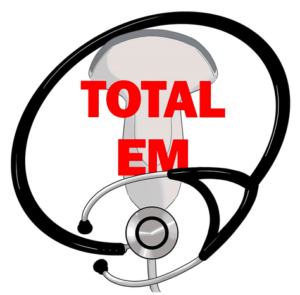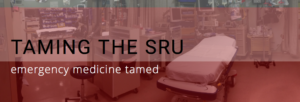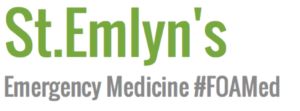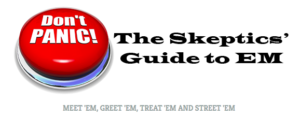Nursing FOAMed Review #13 – September 2019
Total EM podcast #166 is all about patients with PICC lines, and the possible complications that you may face in the ED when presented with these patients. I don’t get a lot of PICC line patients in my ED – but this was a great review and refresher. Listen if you want to know what to do when your PICC won’t flush, if you can’t remember what syringe sizes you want to use, need to know what to do with leaking or bleeding PICCs and what to do when you suspect infection.
Taming the SRU has released a small article concerning syncope in the ED. In case you were wondering if this is something we all struggle with, the answer is a resounding “yes”. Are there diagnostic or prognostic criteria rules that can be applied that can help us decide who needs imaging, PE work-up, and admission? This article reviews the differences between the San Francisco Syncope Rule and the Canadian Syncope Risk Score and even considers just good ol’ physician gestalt. Nothing in this article is groundbreaking – but it is a good review and gives a window into the soul of the physician who is trying to decide what the hell to do with your chief complain “syncope” patient with no other presenting symptoms.
Christopher Winstead-Derlega writes in EMDocs about CHS, or Cannabinoid Hyperemesis Syndrome. I get to see a lot of this in my ED, but I just had a conversation with a nurse in Southern Oregon who sees way more. While the best treatment for CHS is known to be total cessation of cannabinoid substances containing THC, the acute phase of the disease, and the lack of common sense and obvious idiocy of the patient population, makes this a difficult disease to ignore in the ED. The loud full-body wretching is a distraction in any environment, and prolonged fluid depletion can actually make the acute patient high on any triage scale. Read the article for treatment protocol and a great dive into the pathophysiology of the disease. Take a look to learn about the “TRPV1 receptor (transient receptor potential vanilloid subtype 1), which is activated by marijuana, capsaicin and heat, is altered by chronic marijuana use, and [may be] responsible for CHS”
Brit Long gives us a great review of Myasthenia Gravis – pathophysiology, presentation, bedside differential, treatment, and even a link to Josh Farkas’ IBCC chapter on the disease are all included within. There are fantastic pearls within.
- Learn about the “20 word test” and why pulmonary function tests may not influence your decision to intubate or not.
- Why medication lists and autonomic dysfunction may point to a different acute dx on your MG patient presenting in acute distress.
- Why a neuro exam and memorizing SLUDGEMM are important during your bedside exam.
- Learn about the “ice pack test” and it’s 90% sensitivity.
One of the things I thought was really interesting about this article was the “treatment” section – it obviously talked about the need for NIPPV, IVIG and plasmapheresis and the obvious neuro consult, but it conspicuously left out mention of Pyridostigmine. Go to Farkas’ section on this cornerstone treatment for MG in the IBCC already hyperlinked above.
Thinking Critical Care brings us as a lecture from Segun Olusanya concerning Cardiogenic Shock. This is another video found through YouTube from the “Hospitalist and Resuscitationist” conference in May of 2019. Honestly there are some fantastic lectures in this collection, so do yourself a favor and grab a bottle of wine and start watching some more YouTube videos. This lecture is a bit tough to listen to – Dr. Olusanya tends to mumble and speak incredibly fast – but it is worth the occasional rewind, I think. My favorite part of this lecture is the usage the table linked below. How this table is utilized bedside, and how that presentation is then treated based off the position of the patient within this table is pretty fascinating to me. I love any tool that can take critical complex patients and then aid in the simplification of treatment pathways. Take a look at the table and listen to the lecture. 20 minutes of well spent time!
Ryan Radecki from Emergency Medicine Literature of Note always brings us great dogmalysis in Emergency medicine. In this particular piece he shows us the science behind the often repeated mantra of “grab the cultures before the antibiotics”. It’s a pretty simple bit of writing but it’s great. Why repeat dogma when you can truly understand the science behind it? Simply put – before the antibiotics positive cultures = approx. 31%. After the antibiotics = less than 20%. So as Ryan points out here – if you are going through all the trouble of pulling the cultures, you might as well do it before the abx.
ALIEM delivers in September with my favorite bit of FOAMed for the month. Maybe it is because I was a tech for so long and have had so many difficult ultrasound IV “sticks”, or maybe it is just because I think this article is so incredibly well put together – but either way, this review on ultrasound guided IV placement by doctors Kimon Ioannides and Ryan Gibbons is going into my personal “all time favorites pile”. so if you want to know how to better find veins, get that needle tip into the proper spot, and advance that catheter into some tight and tough spots, read this article. I know I’m going to be sharing the hell out of this one.
CORE EM has a great clinical and pathophysiology review for AKA. I honestly haven’t even thought of alcoholic ketoacidosis since I first read about it a few years ago – so it was great to have the refresher. I think with all the DKA we see in EDs, it is easy to forget about AKA – but I know I’ll have it high on the differential list from no won with my known ETOH abusers who appear to have worse than normal labs. I have probably seen a few of these patients in the past couple of years and just not been able to recall this unifying diagnosis for someone who presents with a large anion gap, hypomagnesemia, hypokalemia and acidosis. There are some great review points in this article to include:
- pointers on what to fix first – potassium or glucose?
- how and why to fix electrolyte abnormalities and vitamin deficiencies
- the possible increased risk of mortality in AKA patients
R.E.B.E.L. EM’s Mark Ramzy writes about the first study of its kind comparing 30 day survival of critically sick patients that had critical care initiated in an ED-ICU. The original article comments on a retrospective analysis of critically sick patients that were identified and had ICU level care initiated while in the ED in a separate hybrid ED-ICU located within the ED itself. This ED-ICU is separately staffed, prepared for the sickest emergent patients and equipped specifically for ICU level care, even though it is located in the ED. Long story short – the study finds that if you identify sick patients quickly, provide them with ICU level care immediately, and have proper ICU level staffing for patients requiring intense resuscitation – you guessed it – survival rates go up. This article has been getting a lot of pod-cast time and FOAMed ink – and I believe that it deserves it. I’m hoping that this is the future of big Level-1 EDs across the country. For anyone who has ever worked in an understaffed ED, and had ridiculously unsafe patient to nurse ratios – we all know that our ICU boarders don’t get the level of care they require.
Nickolas Caputo writes about ET02 and pre-intubation oxygenation in another article from R.E.B.E.L. EM. I’d never heard of ET02 before, but I guess if you know what ETCO2 is, then you can figure out what ET02 is. A few interesting things about the original article hyperlinked here – one is that this study shows that pre-oxygenation is shown to be most effective with an NRB at flush rate (basically put the NRB on and crank it up way past the 15 lpm mark). Another is how few patients actually reached the 85% mark for their exhaled 02. An interesting take on another way for us to be monitoring our pre-oxygenation technique and hopefully getting to even fewer post intubation hypoxic injuries.
David Slessor writes for The Bottom Line about the AVERT-Shock trial published in JAMA surgery in late August. For anyone working in a trauma bay this article is quite interesting. Next time you que up the MTP remember that TXA isn’t the only thing that should be on your mind. This authors of AVERT-Shock found that low dose Vasopressin decreased the amount of blood needed to be transfused for bleeding patients, while not contributing to significant side effects. The Bottom Line and other FOAMed bloggers are quick to point out that the findings need to be confirmed in a prospective multi-center trial before application into practice, but the findings are exciting and if the findings ever begin to effect common practice, you’ll be ahead of the curve.
Nursing FOAMed Review #12 (August 2019)
Thinking Critical Care has a link to a lecture on acid/base done by Rory Spiegel. This is from a series called H&R2019 (standing for hospitalist and resuscitationist 2019) – there are more lectures linked to the bottom of the lecture. Guys – I can’t stress this enough – this is one of the most amazing lectures I’ve ever listened to. I have tried at least five different ways of understanding acid/base – and I always come away a bit frustrated. Listening to Rory simplify something this complicated is amazing. Listen, learn, and see why people like me pay money to go see this guy when he lectures.
Listen to enough international FOAMed podcasts and you have definitely heard of Droperidol. What gives? Why can’t we find this drug here in US hospitals?
Never fear – Droperidol is apparently back. Dr. Cisewsky writes for EMDocs about the reintroduction of this once incredibly popular drug. Read the article and find out why you may be getting a lot more verbal orders for Droperidol and hearing a lot less about Haldol.
But wait – you might have done a quick Google search and found out that Droperidol has a black box warning for QT prolongation, leading to possible TdP. So maybe we will just stick with Haloperidol. But then you remember – Haldol prolongs QT as well. The article does a great job thoroughly reviewing the history behind this black box warning – read on and become familiar with a drug that you will probably see a lot more of in the next few years.
Dr. Jenna Pallansch has added to the ToxCard bundle at EMDocs with a really thorough article on toxicological paralysis mimics. This is a HUGE differential – and I don’t know how realistic it is to expect to read something like this and walk away feeling like you have this differential memorized. Honestly, this is the kind of thing where it makes more sense to “save the link” than it does to try to memorize and walk away. While intimidating at first, what I love about articles like these is that they expand the bedside differential for a relatively common ED complaint. Instead of potentially getting lazy (AKA putting 100% of our faith in the gospel of horses over zebras) and oversimplifying every bedside dx, it is really handy to have an article like this to help us remember that complaints like paresthesia and new onset limb weakness have rather complex differentials.
Josh Farkas has added quite a bit to the IBCC (Internet book of critical care) for those that are interested. One of the chapters that I found pretty timely was on VAPI, or Vaping Associated Pulmonary Injury. I have seen a bit on social media recently – a recent article in the Washington Post is making the rounds – about vape addicted kids needing ET tubes. While I have not seen this in my ED, the fact that EMCRIT is taking notice means (to me at least) it isn’t complete bunk. And who is really surprised? You mean to tell me that inhaling a bunch of chemicals directly into the lungs can have health consequences? And the producers of these expensive chemicals say it is perfectly safe? I have NEVER heard of such a thing. Oh… wait. Yes I have.
Rory Speigle continues to talk nerdy to us through his EMNerd series on EMCRIT. “The Case of the Ecological Ambiguity” is a fascinating read on some incredible research done by Maitland et al. Maitland et al published the FEAST and TRACT trials – and really challenge some deeply held Emergency Medicine dogma. But, as Dr. Speigle points out – we haven’t really seen any serious discussion about change in practice since the publication of these trials – mainly due to the concept of “external validity”.
So FEAST shows us that fluid bolus in sepsis (as opposed to sustained drip only) may add to mortality. And TRACT shows that blood transfusion at higher H&H, and the transfusion based maintenance of a higher H&H may ALSO leads to higher mortality. So what is the deal? What does this mean? As Rory points out here at the end of the article:
“We are stuck in an endless cycle of dismissal and denial. A trial like this could not have been done outside of this population, but we are unable to apply the results generally because of the population in which it was conducted. And while it remains unclear whether the results of the TRACT trial are generalizable to blood transfusion strategies outside the confines of this cohort, the results should cause us to question the absurd dichotomy in which we currently exist. Where a patient with a hemoglobin of 7.1 g/dL is fine and that same patient at 6.9 g/dL is in urgent need of red blood cells, with no consideration of the clinical context which surround these abstract data points.”
Following up with EMCRIT’s appraisal of FEAST and TRACT trails, The Bottom Line comments on the TRACT trial as well – and Dr. Fraser Magee gives a very thorough analysis. This trial analysis goes into a deep dive on the numbers and P-values and comes away with what I think is a more measured approach to what they TRACT trial may be showing us. I think that it is worth a read – but if you don’t have the time the “bottom line” is this: Early transfusion for severe anemia is better than delayed, but higher initial blood transfusion volumes, and maintenance of higher H&H are not necessarily clinically superior.
Anand Swaminathan brings us his opinions on the YEARS algorithm adapted for pregnancy. I have already shared the original article in previous FOAMed round ups but will do so again here. Two reasons I wanted to share this again from R.E.B.E.L. EM. The first reason is that I think we may start to see this in EDs soon – the evidence seems pretty solid and god knows we hate sending pregnant patients to US when our suspicion for PE is low, but feel trapped by a lack of negative DDimer. Secondly – it appears that MDCalc now has the algorithm up! This means we have a simple reference to back up the use of the Dimer. If you haven’t heard anything about the YEARS algorithm and how it can be used to streamline pregnant patients out of the ED this is definitely worth the read.
Rick Pescatore writes for R.E.B.E.L. EM about Calcitonin Gene–Related Peptide Receptor Antagonists for migraine headache. HA is a common complaint – and after reading this article I realized that I have been pretty lazy in keeping up with my understanding of the pathophysiology behind this all to common complaint. The study that the article sites is unimpressive and doesn’t really need to be mentioned – this write up is more important as a refresher on migraine treatment and patho than it is as a reference to a new study. Click on the above link – and be ready to go off on some Google tangents if you don’t know, or just want to know more, about:
- Triptan therapy and neuroleptic therapy for HA
- Why opioids might not be working for your migraine patients
- What in the world is a gene-related peptide receptor antagonist?
- Why cerebral vasospasm is a potentially lazy and incorrect explanation of the awful symptoms that your patient is experiencing
Dr. Salim Rezaie from R.E.B.E.L. EM discuses another study published in Resuscitation concerning Epinephrine in out of hospital cardiac arrest. The PARAMEDIC-2 trial has forced the EM community to to confront the available evidence about Epi and how/why we use it. AHA’s ACLS dogma about the sacrosanct place Epi holds in arrest management is being put to the test – and that is what evidence based medicine is all about right? In this review by Rezaie, we see yet more evidence that Epi isn’t the panacea that the AHA preaches.
First10EM brings us a rapid review from Dr. Noren Khamis on Measles. I’m still waiting to see my first confirmed case – but I fear I don’t have much longer to wait. I’m sure that the anti-vax movement will eventually deliver my first patient. The season for the virus is late Winter to Spring – but no better time to learn than now! I like this little refresher because it gives us the brass tacks. Review the viral prodrome, remember to ask where the rash started and why you’re supposed to look at the palms of the hands, and take a look at the fantastic (probably best I’ve seen so far) photo of Koplik’s spots. If you don’t know all of this stuff off the top of your head – just give the article a quick 10 minute read and enjoy the refresher.
Nursing FOAMed Review #11 (May 3rd – May 25th)
Justin Morganstern and First 10 EM show us why Tramadol isn’t a great idea. Ever. I know that there are a lot of providers and nurses out there who love Tramadol. I’m just not one of them. Why? CYP2D6 – that’s why. Don’t know what CYP2D6 is? That’s okay – actually, I’ll amend that – it is probably good. Not knowing about CYP2D6 is probably the sign of a healthy social life. But in case you want to learn about why Tramadol (and also Codeine) are less than optimal options for analgesia, go ahead and click on the hyperlinks. This is fascinating stuff, and Dr. Morganstern does a wonderful job explaining why some folks get 40mg of Tramadol and scream for more pain medication, and other folks get 40mg of Tramadol and then slip into a euphoric slumber. Long story short: these two drugs are opioid pro-drugs – both converted to morphine in the liver by the CYP2D6 enzyme. The only potential problem there, is that some people have faulty CYP2D6 enzymes that poorly convert Tramadol and Codeine to morphine, while others are “super metabolizers” who convert these pro drugs to morphine at up to 17x the rate of a faulty metabolizer. There is a lot of data out there on this – and yet somehow we continue to see these drugs used. Don’t believe me? Just Google “Tramadont”.
emdocs has a handy write up on what to do in the case of an ICD malfunction. There is a lot of great information in this piece, so do a thorough read for all take-home pearls:
- When to grab the magnet and when to leave it where it is.
- Antiarrhythmic choices based on presenting rhythms.
- A few reasons to perhaps ignore that elevated Trop and new onset ST elevation after ICD malfunction.
- A handy “rhythm device identification based on CXR” spreadsheet
Josh Farkas writes for EMCRIT about a study evaluating the safety of immune checkpoint inhibitors for the treatment of septic shock. Now I don’t know about you – but I have heard diddly-squat about checkpoint inhibitors being used for sepsis – and that’s totally okay because that’s not why I’m linking the article – and that’s not why Josh Farkas wrote the article. This article is about the perils of published medical studies – and what kind of garbage can slip under the radar when we don’t read critically. The reason I’m highlighting this article by Josh Farkas is that it dives into the shenanigans that we have to be vigilant about when trying to educate ourselves about medicine. Read this critique – and apply the lessons therein.
The Internet Book of Critical Care (IBCC via EMCRIT) strikes again with a chapter on rhabdomyolysis. Emergency department handling of rhabdo (at least from a nurses perspective) tends to be pretty simple in practice – physical examination and CK lab results = positive or negative rhabdo. But Josh Farkas’ thorough explanation of the pathophysiology, diagnosis and treatment of this disease can really help elevate your nursing skills to another level. Some pearls from the chapter:
- CK isn’t the entire diagnosic story! Look for elevated myoglobin, K, Phos and low calcium
- If treatment is started make sure to track strict I&O – this is the defining factor in continuation or ceasing of fluid resuscitation. (Duh… but how often do we actually track strict I&O in the ED?)
- If you don’t know who Gearoid McMahon is (I sure as hell didn’t) you 100% need to read this chapter.
Ryan Radecki writes for Emergency Medicine Literature of Note and brings us an interesting take on a recent trail published here in the Journal of American College of Cardiology concerning ECPR treatment protocols for cardiogenic shock post AMI. I love the science behind ECMO – and some of the case studies and survival stories are simply amazing. But is ECMO the panacea that advocates sometimes act like it is? Probably not – and I personally take issue with hospitals spending tens of millions on ECMO programs when most of us can’t even hand a newly diagnosed diabetic pt a working take home glucometer. Take a read and let me know what you think.
Bad patient handoffs – one of my pet peeves at shift change. When I get a patient handoff I usually care about 4 things – symptoms, differential or diagnosis, lab values and meds received and ordered. That’s about it. But I typically get none of this information. Usually I end up with a synopsis of the patients personal life, their general attitude towards staff, and whether or not the patient is going to be an “easy one” or not. This is what I call a “doofus report” – as in “thanks for the report doofus” – We’ve talked about the patient, but I still know nothing important concerning the patient’s care. The CanadiEM article reviews handy acronyms like SBAR and IPASS. Read this article from CanadiEM and avoid being a doofus at hand off.
Taming the SRU has a wonderful article and podcast on LVADs and LVAD management in the ED. I work at a “certified LVAD center” – which is scary as hell because the amount of practical experience I have with LVAD emergencies is about as limited as most ED nurses – meaning next to nothing. Unless I suddenly show up to work and get LVADs “all day every day” for the next few weeks, these FOAMed resources are probably about the best training I can get. Take a listen and identify you knowledge gaps! As usual, there are some great pearls in the podcast, including:
- LVADs with over-sewn aortic valve – don’t know what that is or how that affects care?? You need to listen!
- LVAD flow measurements are not necessarily accurate measures of tissue perfusion.
- Diagnosing suction events (hello POCUS), giving fluids and adjustments of pump speeds.
- Continuous flow and resulting GI bleeds (20% to 40% of LVAD pts will develop a GI bleed!)
Nursing FOAMed Review #10 (March 25th – May2nd)
If increased ICP can lead to EKG changes – why not increased pressure in the abdomen? Enter this article by emDocs – an ECG post about the ST elevation variant known as “spiked helmet sign”. Anyone working in a busy emergency department knows that not all ST elevations equal acute MI. Beyond recognition of simple benign early repolarization (BER), there are many other ST elevation EKG signs that should give you a high index of suspicion for alternative causes of acute chest pain. Spiked helmet sign is pretty cool honestly – it is a diagnostic marker of increased pressure within the abdominal cavity that has actually affected the EKG waveform. Even if you aren’t an EKG geek this article is fantastic for another reason – it provides a handy chart of 16 different annotated EKGs with ST elevation, and breaks down the hallmark signs – everything from STEMI to pericarditis to electrolyte abnormalities. There is also a table with 10 different EKGs with ST elevation demonstrating signs that might widen your typical STEMI differential. So with forego the cath lab and drain your patient’s abdomen and fix your patient’s ST elevation.
Next time you’re sitting out in triage and a post-partum patient presents with headache you’ll be glad you read this emDocs practice updates article. Dr. Marina Boushra brings you a very thorough differential – and explains why a post partum patient with headache is potentially a lot less benign than it may seem. The article comes with a handy history-taking graph including 9 pertinent questions as well as a list of symptoms to watch out for. Included in the differential are: primary headache disorders, post-dural puncture headache, pre-eclampsia/eclampsia, meningitis, Posterior Reversible Encephalopathy Syndrome (PRES), stroke, pituitary apoplexy and sinus venous thrombosis. This is some really high impact reading and necessary for anyone who has ever found themselves immediately assuming a simple post-partum headache is just a benign complaint.
St. Emlyn’s has released a wonderful video with University of Maryland’s Dr. George Willis concerning the emergent treatment of aortic aneurisms. Some really great discussion here – some pearls include:
- Access – to go central or peripheral? Do nurses need to hold off on large bore peripherals and set up for a central instead?
- Hemodynamic monitoring – non-invasive BP measurements and which arm to focus on. Pharmacological hemodynamic management based on the soft BP arm or the strong BP arm? Know which side to place that cuff on!
- Why HR is as important as BP in the emergent management of dissection.
- A few good notes on pharmacologic agents. Lipid emulsion Clevidipine is discussed. This is a new one for me – I’ll be asking our attendings about it as soon as I get the chance.
Thinking Critical Care has a really fascinating article on a piece of software being developed by Dr. Lawrence Lynn. If you’ve ever found yourself frustrated trying to define sepsis, you’ll find this article and attached video pretty incredible. Imagine a computer program that correlates the dozens of laboratory markers we know (or maybe just think?) contribute to a septic patient’s prognosis, and then places those markers into a graphic that could potentially tell you whether your treatment modalities are effective or not.
Here is a quote from the discussion about the graphic software: “Research-wise, I think this really opens a whole new world, where different phenotypes of sepsis can be potentially described (work we are currently undertaking), and describing the phenotypes (as opposed to arbitrary cutoff definitions) may lead to better categorization and more importantly therapeutic research that may be better tailored to the phenotype.”
The Bottom Line reviews the Woolum et al trial discussing thiamine administration for septic shock. For anyone who has been diving into the literature on sepsis treatment, this concept isn’t going to look new – but the Woolum trial is a bit different in that it ties thiamine administration with lactate clearance as a marker for treatment efficacy. Now, whether or not you believe that lactate clearance is an important treatment marker (which is, to my understanding, not a universally agreed upon concept), this trail’s conclusions are definitely worth the read. The author’s conclusion: “In patients with septic shock, intravenous thiamine, administered within 24 hours of ICU admission resulted in more rapid lactate clearance and a significantly reduced 28-day mortality.” Okay… so you have our attention. Fans of Dr. Paul Merik’s take on sepsis will find things they love in this article (use of thiamine) and things they hate (the focus on lactate). but go ahead and read the review by Jose Chacko to see why the article’s conclusionsth may or may not be applicable to a more universal septic shock patient population.
R.E.B.E.L.EM brings us more dogmalysis in the form of another nail in the coffin concerning the usefulness of orthostatic vital signs. Dr Anand Swaminathan writes about this article published by White et al in the American Journal of Emergency Medicine – all about the uselessness of orthostatics in predicting 30 day serious outcomes of older patients in the ED presenting with syncopy. Okay – I’ll do your damn orthostatics and get them charted… but it’s probably going to be pretty far down my list of priorities in my busy ED.
And another blow against the concept of contrast induced nephropathy. Dr. Salem Rezaie highlights another study questioning the dogmatic approach fo when/if to give contrast in our sick CT patients… Long story short here – this is a small, retrospective, single center trial, but yet another piece of evidence in our arsenal against withholding contrast in patient’s with elevated creatinine.
EMCRIT’s Josh Farkas brings us another entry for his Internet Book of Critical Care (IBCC) discussing VT/VF storm. There has been a lot of discussion about this over the past couple of years – with nurses running around the resuscitation room trying to make sense of all of these strange new instructions. Why am I getting a second defibrillator? Why are we stopping epinephrine and grabbing Esmolol? What the hell are these guys doing with the ultrasound machine poking around the patient’s neck? If you want to know more about VT/VF storm, why ACLS isn’t being dogmatically followed for every VF code you work, and where the science of cardiac arrest resuscitation may be heading in the near future – this podcast and IBCC chapter is really worth the time it takes to review.
Thank you lord for medical student Josiah Butt and Dr. Mike Xue. These two stellar individuals just posted one of the most useful graphs I’ve come across in a while on CanadiEM. Next time you’re sitting down charting a skin assessment and having a hell of a time remembering the difference between a macular rash, papule, bullae, vesicle or plaque, just remember this post! Dr. Xue walks you through the proper terminology and how to easily remember what is what. This is the kind of simple graphic that is great to print out and just keep handy for a while.
Nursing FOAMed Review #9 (Feb12th – March 24th)
A nice friendly reminder from PULMCCM that we need to pay attention to infection control. Clean those stethoscopes! If you need guideance from the CDC, PULMCCM is kind enough to link to the 161 page study by the CDC on disinfecting guidelines. Seriously. 161 pages. I didn’t read it. But I will be paying more attention to making sure I grab those sani-cloths after every auscultation.
emDocs mentions the ANDROMEDA-SHOCK trial recently published last month in JAMA. This is a really interesting study in that it challenges something that we all seem to know is garbage in and garbage out to begin with – the 2016 Surviving Sepsis Guidelines. Anyone who has ever been forced to hang 30ccs per kilo on a patient who quite obviously doesn’t need it (god forbid we flow that much into someone who could be HARMED by it) knows intrinsically that these guidelines are flawed – even without a deep reading into the literature. to keep the conversation simple, lets just agree that the guidelines state that we should be flushing lactate because lactate is bad. Right? Well… maybe not. A great quote (from a damn great FOAMed resource for those that don’t have it saved on their reading list yet) is here from pulmccm.org: “Within the 2016 Surviving Sepsis Guidelines lies the following recommendation: ‘normalize lactate in patients with elevated lactate levels as a marker of tissue hypo-perfusion.’ This, however, is graded as a weak recommendation, low quality of evidence. Interestingly, buried within the text, the guideline authors declare – correctly – that ‘serum lactate is not a direct measure of tissue perfusion.’ Could there exist a better indicator of tissue starvation in septic shock?”
This is where the ANDROMEDA-SHOCK trial comes into play. You can read all about the possible ramifications of this trial here on emDocs. Can a simple capillary refill test be a better marker for treatment efficacy than serial serum lactate measurements? The answer is: probably. And this is important – because what is means is that we may be able to potentially use another tool/marker – and ditch the high volume fluid boluses used to flush lactate during sepsis treatment. I wonder when we will get a tie in from my favorite sepsis treatment protocol skeptic Dr. Paul Merik?
Another altered patient roles into the ED through the ambulance bay. Is it time to bust out my favorite ridiculous diagnostic acronym AEIOUTIPS? Let’s hope not – with upwards of 20 separate etiologies in the bedside diagnostic differential for that acronym, I find it worse than useless. But let’s pretend that I’m able to remember all 20+ possible diagnoses within that insane acronym – this article from emDocs focuses on hepatic encephalopathy. (Somewhere buried in the E portion of the acronym, if you were wondering.) Doctors Setareh Mohammadie and Amy Zeidan have a trove of wonderful information here about HE. Some of the clinical pearls include:
- One study showed that over 630,000 adults in the United States in 1999 had cirrhosis. “With sweeping epidemics of hepatitis C related to IVDU over the last decade, these numbers likely represent an underestimation of data for 2018 and beyond.”
- Early clinical signs of HE can be insidious and include small personality changes such as sleepiness, apathy and loss of inhibition.
- There is an entire paragraph on the use of ammonia levels and it’s use as a diagnostic criteria. This paragraph alone is worth a serious read. Suffice it to say that ammonia alone is a poor diagnostic tool for HE.
- The article stresses the importance of paying close attention to serum sodium levels and possible dehydration as precipitating factors to HE. There is a great breakdown of the pathophysiology behind both processes.
St-Emlyn’s talks about P-Values and what they mean. If you like to read medical trials and don’t pay attention to p values, you really need to listen to this lecture. This is a great little podcast. It is only about 11 minutes long – but it packs a real punch in that it can really hone your ability to figure out what literature can be useful in your nursing practice, and what is just “good enough” to publish – but not necessarily applicable to your clinical setting.
- Null hypotheses – states that there is no difference between two treatments. Testing the null hypothesis shows that there may actually be a difference.
- the magical value of 0.05 – why it matters and why it doesn’t.
- What is a fragility index? Why is this important in context of p values?
- Why statistical relevance isn’t as important as clinical relevance.
emlitofnote.com has a pretty good write up on fragility index here, as well as a good explanation as to why, perhaps, a lot of recommendations from the EM studies we see may not be implemented any time soon. The article on emlitofnote.com is in reference to this article in Annuls of Emergency Medicine which found that the average fragility index in 180 randomized EM trials was only 4. Ouch. For those of you that are bad with statistics (like me…), what this simply means is this: if you were to take 4 patients and switch their results in a trial, you would get the opposite result for the trial. Fragile indeed. To put this another way – lets say we have a trial testing whether a certain dose of Epi is helpful for hypotension. 400 pt are enrolled and make it into the trial. So n = 400. Lets say the trial shows that the dose of Epi is indeed effective – the p value is 0.05 but the fragility score is 1. That means that if only 1 of the 400 patients had a different result, the entire trail would have the opposite outcome. Fragility index is important specifically because it helps us look beyond p values.
EMCRIT podcast #241 goes over more on the ANDROMEDA-SHOCK trial as well as the CENSER trial. Scott Weingart always has a lot to say about sepsis treatments – his take on the ANDROMEDA-SHOCK trial is interesting, and his breakdown of the CENSER trial is pretty spot on. I always advocate for early pressor use in my sick sepsis patients – but let’s be honest – there is a lot of fuzziness out there concerning pressors in the ED for septic patients. Which one to use, how early, what dose, which patients really need it, does it decrease hospital stays, etc etc etc. The CENSER trial is great because it gives us a low-risk, one size fits all solution. Low dose norepinephrine for our sick ED septic shock patients (define shock as MAP <65 in this studies population) to reduce mortality. Sounds too good to be true? Take a listen and see what Scott says.
Just in case you were interested, more on the CENSER trial here at The Bottom Line. As usual with The Bottom Line, the “strengths and weaknesses” portion of the review are incredibly helpful – especially when concerning the clinical external validity of a single center trial done in a relatively low ICU resource hospital.
Also, this just in from our friends at ALiEM – you need to hug your EM residents and tell them that you love them more. Seriously though. Also, in the increasingly strange meta world of medical literature and publishing – ALiEM submitted their study to Annuls of Emergency Medicine and the FOAMed study was published in the print world.
Taming the SRU brings us possibly the most information packed article in the FOAMed pack this last month with their discussion of the CBC. While this article may send you down a wiki black hole in search for definitions of diseases and abbreviations you may not remember – it is truly amazing if only for the infographic put together by someone who deserves a round of beers from all of us who will be pouring over this graphic for the next few weeks. I would estimate that about 100% of the patients I grab labs on get a CBC. If you are like me and only do a cursory read of the results from this lab, this article is for you!
If you work in a trauma center and are familiar with REBOA usage you might be in store for a bit of a sea change when it comes to the paradigm behind REBOA usage. REBELEM shares a post on why REBOA utilization may be getting a fresh look. Zaf Qasim of University of Pennsylvania school of medicine writes about JAMAs article: “Nationwide Analysis of Resuscitative Endovascular Balloon Occlusion of the Aorta in Civilian Trauma”. The study’s conclusions may be sensational, but don’t just skim through. Read JAMAs article but make sure to then read Qasim’s careful analysis. Long story short here: “placement of REBOA in severely injured trauma patients was associated with higher mortality compared with a similar cohort of patients who did not undergo REBOA placement.” But, per usual, there is a lot of nuance that can be missed when one just reads through an abstract and then skims the conclusions. There are 8 separate bullet points in Qasim’s analysis of the JAMA article that are very worth a thorough read. Either way – if you use REBOA in your trauma bay, this is a great bit of FOAMed worth sharing.
Nursing FOAMed Review #8 (Feb 1st – Feb 11th)

The large amount of cancer patients we receive in the ED shouldn’t really surprise anyone – cancer is the second leading cause of death globally. But nursing school does a poor job of preparing us for these ED visits. There is an oncology section in every Med Surg nursing text, but when a renal cell carcinoma pt visits your ED, you aren’t going to be treating his RCC – you will most likely be emergently treating a disease process caused by his RCC treatment. This EMDOCS post is a great refresher for some of the more common cancer related emergencies we see in our EDs. Some interesting pearls:
- IDSA guidelines for febrile neutropenia
- Why your cancer pt presenting as an appendicitis pt may actually have necrotizing enterocolitis.
- SVC Syndrome and a pretty cool bedside test called the Pemberton’s sign
- Just in case AEIOU-TIPS wasn’t a long enough acronym for altered mental status, remember that the list increases with oncological emergencies to include: “CNS metastases, raised ICP, electrolyte disturbances such as hypercalcemia, medication side effects, and hyperviscosity syndrome”.
- Renal failure and Rasburicase – also when and what to look for in Tumor Lysis Syndrome
Don’t know the difference between a partial simple seizure and a partial complex seizure? Having trouble remembering whether to prep for EEG, EKG or NCHCT? Don’t worry. EMDOCS has reposted a great review from CoreEM. Simple algorithms, and even simpler hand drawn diagrams, can help you remember what is what. This is a worthwhile 5 minute read.

If you have a difficult time with endocrine patho (doesn’t everyone?) EMCRIT has published a new chapter in the Internet Book Of Critical Care that is perfect for you. Thryoid storm has a high mortality and high missed diagnosis rate. Review Josh Farkas’ new chapter and come prepared.
- Clinical presentation along with a list of precipitating factors
- Beta Blockers – why we need to proceed with caution. Also an interesting aside on the use of Esmolol vs Propanolol
- A great thyroid storm treatment checklist in order to check and see if you are educated about/prepared for multiple treatment modalities.
- Watch the attached video from EMin5 at the bottom of the IBCC chapter.
- http://emcrit.org/ibcc/thyroid-storm/
Rory Spiegel explains why we don’t need to work up every patient presenting in the ED for PE. Spitting in the eye of the results of the PESIT trial is fun, spitting in the eye of the results of the PESIT trial because there is better data published in Annuls of Emergency Medicine is more fun. So read this, and now you can shake your head in disbelief every time someone orders a CT on a well appearing patient who had an idiopathic syncopal episode – AND cite a good source as the reason you’re why you are shaking your head.
More on REBELEM on this particular subject here

Short and simple from ALiEM, Jennifer Rabjohns brings us a review on ETCO2 and why we should be using it during our resuscitation efforts. If you aren’t using ETCO2 you’re really missing the boat. This tool helps us shape care, manage airways, decide on efficacy of compressions, and even gives us information that is useful in deciding when to “call the code” in patients that aren’t responding well to resuscitation. Not that I think that AHA is right all the time, but this is a standard of care in resuscitation – and one that I think we can all get behind.

CanadiEM throws more shade at the AHA’s infatuation with post resuscitation “Targeted Temperature Management” or TTM. Formerly known as “Therapeutic Hypothermia”, TTM is what I can only guess is the AHAs attempt to put this intervention on life support while they desperately search for ANYTHING that bolsters their argument for its use over the last 15 years. TTM isn’t causing harm. So there is that. So I would never waste my breath arguing AGAINST TTM – but good evidence supporting its use across the board for EVERY ROSC patient? I’m still looking for something that gives me the aggressive optimism displayed by the AHA.

CORE EM via Michelle Romeo has a great review on Le Fort fractures for all you trauma junkies out there. Check out this article for:
- Visual anatomic break downs of the different Le Fort fractures (type I, II and III)
- Management criteria with some really interesting pearls (43.5% of Le Fort III fractures require tracheostomy!?)

So at first I wasn’t going to write anything about this. But First10EM was the third or fourth FOAMed site that I saw with a review on this the NEJM article Andexanet Alpha. This is a worthwhile read for a number of reasons:
- The tyranny of for profit medical publications in knowledge transfer bias is a worthwhile discussion for anyone interested in EBM. The democratizing effect of FOAMed knowledge transfer comes with its own downsides – but not acknowledging the implicit biases in the design of for-profit medical publications is worse than dangerous.
- Justin Morgenstern does a really fantastic job breaking down some of the interesting tricks that go into questionable medical science publishing. I refrain from calling it junk – but there is an argument to be made there as well. How do drug companies manage to publish trials that show great outcomes when there is no scientific evidence of a great outcome? Read this article and click on some of the hyperlinks to find out.
- A lot of these expensive reversal agents on the market seem to slip into use in the same manner as Andexanet. KCentra is another one of these drugs with great optics but questionable patient outcome applications. See Rory Spiegel’s opinions about KCentra here and here.

I’ve been doing ultra sound guided IVs for a couple of years now – and I can say from a lot of bedside experience that it is a safe and dependable way to get access on your “hard stick” patients. Dr. Salem Rezaie from R..E.B.E.L.EM has a pretty great review on the efficacy and use of this procedure here, and there are some really interesting point:
- Discussion of bevel up vs bevel down for USIV placement.
- Why we should, or maybe should not, be using tegederms as barriers for our US probes???
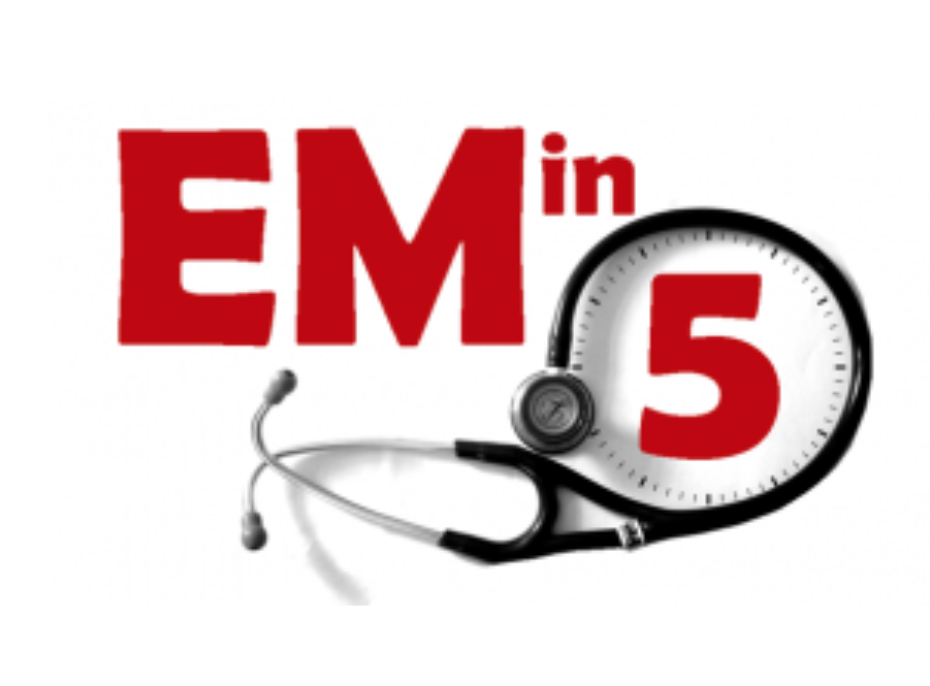
I know that this is supposed to be an early February FOAMed review, But Dr Anna Pickens put out a great EMin5 video about measles. And I think we all know that we need to be more vigilant now about potential measles patients in our EDs. Every time a parent trusts a washed up 90s quasi porn star pop culture icon more than they trust science, we end up with an unvaccinated experiment walking into our ED. Watch and learn – and remain vigilant in the face of idiocy.
- 90% transmission rates??
- Contagious droplets in air for up to 2 HOURS??? Incredible
- How to look for Koplic spots – (I didn’t even know what Koplic spots were before this 5 minute video)
Nursing FOAMed Review #7 (Nov 2nd – Nov 25th)
In a review on emDocs Lloyd Tannanbaum explains the physiologic causes of widening pulse pressures and bradycardia in Cushing’s Triad. So if you want a quick review of Cushing’s (i.e. why increasing CO2 leads to a MAP increase and the baroreceptor response) this is a great 5 minute read. The article’s main topic isn’t Cushing’s Triad though – it is the ECG changes that one can expect to see when dealing with a patient experiencing increased ICP. Tannenbaum sites an article that shows up to 56% of patients experiencing increased ICP will have a variety of ECG changes including ST depression, QT prolongation and T-Wave inversions. There is also mention of increased troponin – so how do we differentiate between MI and cerebral hemorrhage? The article continues to explain and dives into an explanation on “Cerebral T-Waves”. Great references at the end of the write up, with links to more articles and ECG samples on the Life in the Fast Lane FOAMed site.
Charles Murchison doesn’t want you to keep using Sodium Bicarbonate. In his review on emDocs he breaks down the evidence for Sodium Bicarbonate’s use in fighting acidosis – and systematically argues against the drug’s efficacy. The physiology review is so interesting, I can say that this has been my favorite FOAMed article read in the past couple of weeks. Some very cool pearls –
- Acidosis may not need as much correcting as we think – arguments (with peer reviewed reference obviously) for why acidosis my help the body in crisis states.
- A step by step chemistry and physiology process of how NaHCO3 “fixes” acidosis – and why your metabolic acidosis will convert to a respiratory acidosis if NaHCO3 does it’s job correctly. He argues that if you can’t ventilate off the extra acid, as is the case in a typical cardiac resuscitation, the NaHCO3 may be futile.
- A direct pull from the article: “50 mL or 50 meq of 8.4% sodium bicarbonate – will raise the Na by 1.0 meq and increase ECV by 250 mL”. Yikes right?
- A quick literature review discusses why there is so little evidence to support sodium bicarbonate’s use during cardiac arrest.
It looks like St. Emlyn’s is commenting on the giant body of evidence questioning the efficacy of neuro-protective hypothermia. Dr. Dan Horner writes in St. Emlyn’s about JAMA’s POLAR trial – and the results aren’t really all that surprising. Simply put, POLAR is a high quality RCT (N=511) that shows no real difference in outcomes for patients that underwent hypothermic protocols post TBI vs those that were not subjected to cooling. If you are interested in studies that show the efficacy (or non-efficacy) of hypothermic treatments, this is an interesting read. Advocates of hypothermia are found in trauma, cardiology, resuscitology, neurology and all different kinds of “ology” – but at the end of the day it seems like recommendations for these treatments are based more on bench concepts and less on actual practical results. I’ll continue to keep an eye on hypothermia RCTs for post cardiac arrest patients – but as long as AHA pushes hypothermic protocols for every comatose ROSC patient, I’m sure we will continue to see these studies produced. As long as these studies aren’t showing that hypothermia is causing harm, I don’t think that we will see a huge push to ditch hypothermia-based protocols, but is this really an effective treatment? We will have to keep an eye out for more literature and how it affects our future treatment guidelines.
Total EM podcast #120 is all about tics and tic borne illnesses. If you like infectious disease, this Total EM podcast is a fascinating half hour discussion between Dr. Chip Lang and Dr. Michelle Perkins. If you don’t have time to listen there is a great write up here.
- Doxycycline is the antibiotic of choice for the majority of these tic-transmitted infections.
- Doxycycline is safe for use in children – all the tooth staining contraindications we learning about are true for tetracycline – but doxycycline is in the clear.
- Lyme and all of its controversy – including cardiac manifestations for lyme, which are really interesting. (Trigger warning for those of us who rail against “chronic lyme”)
- A quick discussion about tic-borne infection diagnostic labs
- Really thorough photographic entomology review for tics
Of note for those that wish to do a bit more of a “deep dive” for some of the AHA PALS basics out there – Total EM podcast #121 is dedicated to the emergent treatment of croup. Some really great info in here concerning risk stratification, when and when not to use epi, and why not every croup case is solvable by humidified air. This one is definitely worth a listen as we move into the croup season.
Dr. Josh Farkas adds another chapter in the Internet Book of Critical Care with something that everyone is familiar with – Hyperkalemia. We’ve all seen enough of these patients to know how serious they can be. But if you have worked in 5 different critical care areas, you have probably seen about 25 different ways to treat this potentially life threatening electrolyte imbalance. Listen to the 20 minute podcast for a great rundown of the IBCC chapter.
- EKG changes – what to expect and what NOT to expect. Why EKGs can help our prognostic/diagnostic outlook, but why we need a more holistic approach.
- Pseudo Hyper K / Iatrogenic (Including Heparin!) / extracellular acidosis DKA or HHS / cellular lysis / renal failure / RAS dysfunction
- a quick conversion about risk analysis for your hyperkalemia patients.
- Why kayexalate probably has no place in emergency care of hyperkalemia
- Why our NS vs LR dogma is harming our patients! Put the NS away and grab LR (or maybe isotonic bicarb drips!).
Dr Emily Roblee writes for Taming the SRU about preeclampsia in the ED. Any nurse who sits at triage will want to read this article from beginning to end. As Dr Roblee points out, preeclampsia is a “can’t miss” emergency – if we don’t catch preeclampsia we could contribute to significant increases in the patient’s mortality/morbidity. There are some really fantastic PDFs in this article that do a wonderful job of graphically simplifying the information presented. Among the pearls in this article –
- Wonderful breakdown of symptoms that should make us suspicious of preeclampsia at the triage station. It’s not all about the BP.
- A quick guide to differentiating between chronic hypertension of pregnancy: , gestational hypertension, preeclampsia and actual eclampsia
- A quick discussion about HELLP
- Lab work and a breakdown of the evidence behind the risk factors as shown on our lab results.
Nursing FOAMed Review #6 (Oct 13th – Nov 1st)
Ryan Radecki shares his thought on Emergency Medicine Literature of Note about the PREMVA trial. Bacterial Vaginosis is associated with premature labor. So treatment of early-detected BV should result in fewer pre term deliveries right? Apparently not. The full text from the Lancet website can be found here. Whether this changes practices across EDs or not is doubtful – but blind, prospective RCTs that test dogma are important for just this reason. A great commentary by Radecki and why these seemingly simple trails have such an important place in EBM.
Dr. Skyler Lentz shares his thoughts on emDocs concerning emergency airway support for patients presenting with respiratory distress due to pneumonia. In short, this is a great discussion (linked with citations) about when to consider the use of NiPPV (Non invasive positive pressure ventilations, i.e. BiPAP, or CPAP), intubation or HFNC (high flow nasal cannula).
Dr. Lentz explains his thoughts concerning HFNC as the first airway intervention in certain patients presenting ot the ED with acute respiratory distress due to suspected non-complicated pneumonia. There is evidence seems to indicate that HFNC leads to a decreased mortality in this particular patient population. This may seem like splitting hairs, but for anyone who has watched a patient struggle against a BiPAP machine, the idea of being able to switch out NiPPV for HFNC seems like a fantastic idea.
emDocs also has this review on insulin as a treatment for hyperkalemia. Thank you Kayvan Moussavi, PharmD and Scott Fitter, PharmD for a really well put together article! At first glance this looks like a pretty simple paper discussing dosing recommendations – but read carefully and you’ll see some VERY cool pearls. My favorite part of this review is that it purports to give a range for potassium depletion with the typical 10 units of insulin dose that most ED nurses are familiar with. Expect a drop of 0.6 to 1.2 mEq/1h with your boilerplate 10-unit dose. I’ve been looking for that number for about 6 months – so I’m super happy to have that number handy. You’ll also find some great warnings about insulin dosing and rebound hypoglycemia – especially in the ESRD patient. Expect the potential for hypoglycemia up to 6 hours, YES 6 HOURS, after insulin administration; and the probability of that rebound hypoglycemia occurring rises in our patients with poor kidney function.
Owner and editor in chief of St. Emlyn’s, Dr. Simon Carley, writes about the prospects for learning, mentoring, and continuing education while working in a busy ED. Anyone who works in a busy environment should read this article. If you work in an inner city ED, or any level 1 Trauma, you probably feel pretty overwhelmed most of the time. Unsafe patient ratios, stacked hallways, and double-digit hour wait times are all normal. But how is it that most of us end up walking away from these experiences with an educational net gain. We find ways to make it work – and we innovate informal ways to help mentor and teach each other. Dr. Carley gives us some great advice in this article – and better than advice, he actually shares some of his teaching techniques that he feels are perfect for busy EDs. Read, share and repost. This is one of the most inspiring things I’ve read in a long time.
EMCrit has a great podcast with Zack Shinar and Scott Weingart about the science behind our cardiac arrest interventions. This is a wonderful review of some of the most cutting edge science behind our more advanced intervention options (VF storm arrest algorithms and ECPR) as well as a very thorough “rethinking” of our pre-hospital treatment options and prognostic guidelines. Listen if resuscitation is your thing. Maybe listen twice if it isn’t. Among the great discussion points in the podcast and EMCrit write up are:
- Pre-hospital prognostication guidelines
- How to think about “no-flow” and “low-flow” times
- Discussions of programs with up to 40% survival rates on initiated ECPR!
- Perhaps a new way of thinking about asystolic arrests in the ED?
- Cost of quality adjusted life year with ECPR (or any ECMO) vs. other extremely expensive interventions for other diseases. An interesting “rationalization” of the cost of ECPR in inner city EDs.
Howard Greller writes about huffing (dusting, sniffing, etc) in a new Tox and Hound installment on EMCrit. When I was still a medic I used to pick up a lot of obtunded kids that huffed Dust-Off or other inhalants. Some of them went into cardiac arrest. Interestingly, our protocol was always to call poison control (1-800-222-1222 – if you don’t have that number memorized … well, there you have it!) and every time, EVERY SINLGE TIME, I was told to administer benzodiazepines. That probably didn’t help much and this article explains why.
- If you know your patient was “dusting” your patient has a chance of going into sudden cardiac arrest – and if they haven’t died yet, make sure you don’t give them the opportunity to experience a sudden catecholamine surge.
- Your huffing patient is less of a respiratory patient and probably more of a high risk cardiac patient – they need to be kept on a cardiac monitor at all times!
- Beta Blockers or Amiodarone might be a better idea than a Benzo
Dr. Amy Chung on CanadiEM has an article reviewing the possible ED visits nurses may encounter related to irAEs. You don’t know what irAEs are? Well, that’s okay. I’d never heard of anything referred to as an “irAE” either. But I have heard a little about Immune Checkpoint Inhibitors. And I have heard the names of drugs referred to as biologics and immunologics like: ipilimumab, nivolumab, pembrolizumab, atezolizumab, durvalumab.
This is a review on the toxilogical events that can be caused by a group of drugs that are so new to oncology that they haven’t even made their way into our nursing pharmacology text books. Take a gander and walk away with some pretty good pearls:
- unlike chemotherapy, which targets and destroys cells, these drugs proliferate immunologic responses – toxic events are going to be treated the same as an autoimmune flare-up.
- take a look at the three different types of Immune Checkpoint Inhibitors – and maybe even memorize which ones are more likely to cause irAEs.
- the article has a great table of common presentations or irAEs and even a chart that grades of severity of common symptoms – along with guidelines for probable treatments.
Dr Lauren Westafer speaks on the SGEM about more medical dogmalysis. (Podcast Link Here) There has been a lot of talk in the FOAMed community recently about contrast CT and related AKI. Every ED nurse I know has had at least one experience where he/she has had to wait bedside for a creatinine blood result before transporting a severely ill patient for much needed CTA. Suspected stroke but no access? Wait for the creat before CTA. Other examples abound. But it looks like we have been waiting for nothing. SGEM#234 is here with a really fantastic review of the newest evidence against CTA associated AKI. It can all be summed up here with the SGEM’s bottom line: “The risk of AKI from CT contrast is not as great as it was thought to be, and it might not even exist. The risk of missed or delayed diagnosis likely outweighs any from the exposure in a patient who requires a contrast CT study.”
Listen to the SGEM – and then try to convince the radiologists that we don’t need to wait for the creat before CTA!
Just a fun thing here from Taming the SRU – how to make paperclip eyelid retractors. Patient can’t open his/her eye and you can’t touch the orbit or lid because of pain response? Need to get a good glance at that globe? Just follow these instructions and you’ll have eyelid retractors in no time. Little learned skills like these can save us time in already stretched-thin EDs. They can also decrease patient morbidity. While everyone else is running around trying to find the misplaced ring cutter, you could be the one using string (I use iodoform gauze) to take off that ring. These random skills have a valued place in any nurse practice.
Christina Shenvi and Leah Hatfield write in Emergency Physician Monthly about Kratom – AKA: Thang, Kakuam, Thom, Ketum, Krypton, Ketum and Thom, among others. Never heard of it? Me neither – but it is a legal drug of abuse and has effects similar to opioids at high doses. With the opioid crisis in full swing, and with Kratom being known “on the streets” as a legal option/drug that can alleviate opioid withdrawal, we may be seeing some Kratom patients in our EDs.
Dr Selim Rezaie gives us more ammunition in the fight against Tamiflu. He presents three different studies that tackle the efficacy of Tamiflu – and as you can probably guess, the results are underwhelming. So again – unless your patient is very old, or very immunocompromised (or maybe you think they’ll just really enjoy diarrhea on top of their typical flu symptoms) Tamiflu is probably not worth the cost of the drug. Tell that to Roche – the company has made more than $18 billion off Tamiflu since they released the drug in 1999.
Nursing FOAMed Review #5 (Sept 23rd – Oct 12th)
emDocs has a new Tox Card for pediatric ingestion of button batteries. I have always been told that these ingestions are dangerous, and need to be treated as potentially life threatening emergencies, but I think that this is the first real article I’ve ever come across on the subject. Some very good clinical pearls for nurses here including:
- What to expect at triage with initial presentation – some common signs and symptoms
- X-Ray findings (very cool “halo” or “double shadow” sign)
- Understanding that serious injury can occur in as little as 30 minutes and necrosis can occur in as little as 2 hours
- the potential dangers of co-ingestion with magnets
A great review if you ever triage pediatric patients, and/or you don’t already currently feel like you’re an expert on toxic sequelae of battery ingestion.
Brush up on the significant signs and symptoms that would increase your clinical suspicion (and nurse-led triage potential diagnosis) for compartment syndrome in this article from emDocs by Brit Long MD. We were all taught the “5 P’s” during nursing school – but a quick review shows that most of these signs are horrendously non-sensitive (13% to 19%), so going over lab values and alternative methods to solidify a clinical diagnosis is necessary. The article also goes over risk factors, advanced diagnostic techniques (probably left for the practitioners but some POCUS options are available for the braver and more comfortable bedside nurse), and some bedside management techniques such as affected limb placement and splint removal.
Most importantly Dr. Brit explains that this is a time sensitive surgical emergency. Mortality and morbidity increase drastically if the diagnosis is missed, with one study showing irreversible damage and tissue necrosis in up to 37% of cases after only 3 hours of symptom onset! The first person to suspect this diagnosis should be the triage or bedside nurse. Review the article to brush up on the basic signs, symptoms and risk factors.
Is that wide or is it narrow? Ventricular or supraventricular? This review by Lloyd Tannenbaum MD goes through a myriad of ways to differentiate between wide complex supraventricular aberrancies, versus true ventricular driven tachycardias. There are some great pointers in here, which include a very difficult EKG and case study from Dr. Amal Mattu (does he ever do easy EKGs?). The article walks you through the different diagnosis criteria step by step. But at the end of the day, this article is the same as the other thousand articles on this topic – until you get to the very end. So yeah… we slog through a half dozen incredibly complicated methods to differential SVT with aberrancies versus VT. Most of these methods I only half comprehend and, truthfully, don’t really see myself using at the bedside (maybe later in the break room I’ll steal some calipers and geek out). but then at the end of the article Dr. Tannenbaum shares an article published in 2010 by Brugade et al that shows that if RWPT (R Wave Peak Time) in lead II is over 0.050 seconds (basically a little bit more than 1 small box on your EKG strip) you have a high specificity for VT. Holy hell… this is why you have to read all the way to the end!
Ryan Radecki writes in Emergency Literature of Note about one of my favorite topics: surgery vs. antibiotics for acute appendicitis. If you aren’t familiar with the arguments against surgery for every acute appendicitis patient presenting in your ED, a quick GoogleFOAM search will really open your eyes to the controversy of the American mode of treatment. Anyway… JAMA recently published the 5 year follow up results of the APPAC trial (done in Finland) and the results are pretty interesting. Short but sweet: 40% of the patients that are sent home on antibiotics come back for surgery within 5 years. That sucks for the antibiotics proponents. Or does it? If you look at these results from a different angle – we just avoided surgery on 60% of our appendicitis patients. Really interesting commentary by Dr. Redecki.
EmCrit also wrote about the results here – with further amazing opinions and commentary from the ever-present Rory Spiegel. Rory correctly asks the question: “Are there specific markers that predict patients who will go on to fail medical management?” I would love to see someone retrospectively go back to the APPAC trial and see if it is possible to score the patients using the Alvarado Score for Acute Appendicitis. Do lower scores result in lower return surgical visits? Who wants to commit some time and help me do a retrospective look?
Josh Farkas writes for PulmCrit about using phenobarbital for acute alcohol withdrawal. Of all the Attendings I work with, I only know one that uses phenobarbital instead of benzodiazepines. After reading this article I wish everyone I worked with would ditch the benzos. Some great points in this article include:
- Without the benzodiazepines we can get rid of the ridiculously complicated CIWA-Ar scale and replace it with a very simple RASS (Richmond Agitation Sedation Scale)
- Phenobarbitol results in fewer unneeded intubations.
- We basically can’t overdose our patients with phenobarbital if we use common sense
We all need to take a moment in the next few weeks and take a look at the two “Tox and Hound” entries in EmCrit concerning synthetic cannabinoids. Anyone working in inner-city emergency medicine knows that we get a fair number of “K2” patients rolling through the doors. These patients are scary and unpredictable. The vast majority will be hallway MTFers and we will keep watch while they “metabolize to freedom”. But some of them die, and there is rarely anything we can do about it. Read here to learn about the history behind synthetic cannabinoids and why we probably won’t see a decrease in these patients for some time. Read here to learn about one of the scariest outcomes from a subset of these patients who may be smoking “super warfarins” and why we sometimes see massive hemorrhage in this population. Very interesting stuff.
Two things about this article from RESUS.ME. One – It is a fantastic break down on how to, and how not to, manipulate your patient’s arm when they have a humeral head IO placed. Two – this is the first post on one of my favorite FOAMed blogs since April, so I’m pretty excited. Hopefully we will have more from RESUS.ME soon.
So here is the result: you can abduct the arm and rotate the humeral head inferiorly (think “thumbs down”), but you cannot abduct and rotate anteriorly (think “stick ‘em up!”). There is a very cool video with IO placement on a cadaver and the results of the various patient shoulder manipulation techniques on IO placement, as well as the actual damage done to the IO needle when anterior rotation is combined with abduction. (Take a look at the literature review at the end of the article to get a glimpse at some of the cool articles published in journals on IO efficacy vs other types of peripheral access.)
Should nurses be taking off the c-collar in the triage area? According to Kevin Milne at the SGEM, the answer is a resounding “yes”. According to a study published by the Annuls of Emergency Medicine in Oct 2018 (full text available for free online), if nurses are properly trained to remove c-spine precautions, the chances of them inappropriately clearing c-spine is incredibly low. In fact, for this particular trial, the nurses under the microscope … ready for this?… “triage nurses removed 41% of immobilized patients’ collars and missed zero c-spine injuries.” That is incredible. The idea here is that triage nurse removal of inappropriate c-spine precautions can cut ED output and throughput times. Amazing idea right? The hyperlink will take you to the SGEM website, but the podcast is always worth a listen.
SMACC has a great podcast on the benefits of trying to practice evidence-based medicine, and why it is our best bet in the fight against medical mumbo-jumbo. Justin Morganstern (from First10EM) is the speaker – and if you go to the hyperlinked website above you can view the power point presentation along with the podcast if you want to follow along with the lecture. Listen if you want to hear an EBM take on why:
- pop media is a terrible source for medical information
- external validity is always something we should question
- meta-analysis can be garbage science
- there is an important distinction between false positives and over-diagnosis
Overall this is just a very entertaining 35 minutes of FOAMed podcasting brought to you by the SMACC team. This is definitely worth a listen.
Michael Misch writes for Emergency Medicine Cases and presents us with a critical patient suffering from a GI bleed. What’s the catch? The patient is utilizing an LVAD. LVAD cases are nightmare scenarios for most ED nurses to begin with – but what happens when your patient has an LVAD, but a chief complaint separate from the LVAD device itself? What’s worse than a nightmare? Night terror? I dunno.
This is a great article to read carefully and thoroughly. Lots of peals here for the ED nurse.
- How do we get a full set of reliable vitals (blood pressure anyone?) on a patient with an LVAD?
- Beyond assessing the patient – how do we assess the device?
- How LVAD pumps and medications that are necessary for life on an LVAD can affect your patient’s other acute emergency issues/diagnoses.
- The importance of POCUS in motoring fluid volume and resuscitation.
This is a really great read. Even if you feel comfortable with LVAD patients ask yourself this – do you feel comfortable being the primary emergency nurse with LVAD patients that have something else wrong with them other than the LVAD? If you work in a VAD center, you train and prepare to deal with LVAD patients presenting to you ED with cardiac issues or LVAD trouble shooting issues. But what about LVAD + Sepsis, or LVAD + GI bleed? Read and prepare!
Nursing FOAMed Review #4 (Sept 10th – Sept 22nd)
R.E.B.E.L.em goes beyond the AHA PALS requirements and brings us an article summarizing the beside creation of the Epinephrine push for the hemodynamically unstable pediatric patient. We’ve all seen the BristoJet Epi taken out of the crash cart and used on a crashing patient. This technique is often used – 1 to 2 mL of 1:10,000 Epinephrine pushed as a stop-gap between the team noticing a falling BP and getting the formal adrenergic drip de-jour dialed in and working. But what to do for the crashing or post resuscitation pediatric patient?
So let’s go back to some nursing pediatric resuscitation basics here. Epi dose for peds is 0.01 mg per kg. Sure – we all know that (or at least we should). But how do we make the Epi push needed to bridge until we get our Epi drip dialed in for the crashing pediatric patient? You just need to create your own 10cc BristoJet of Epi in a dose that matches your pediatric patient’s weight! Read the article for more detail, but here is the meat and potatoes:
- Step 1 – get your pediatric resuscitation Epi push dose (the aforementioned 0.01 mg/kg) and draw it up into a 10cc syringe.
- Step 2 – dilute the dose with NS until the 10cc syringe is full.
- Step 3 – push 1 cc at a time for your crashing patient- the same as you would for an adult.
This is a really cool article that gets into a great and simple method of making emergent Epinephrine pushes bedside. The folks at R.E.B.E.L.em call this an Epi-Spritzer. (Apparently there are a lot of names circulating for this type of bedside Epi push.) Either way what ends up happening here is a 1mcg/kg push, 1 cc at a time, from a 10cc syringe – and there is evidence that this may be best practice. All of the evidence, of course, is outlined beautifully (with hyperlinks) in the article itself.
Rob Bryant writes for R.E.B.E.L.EM about the BICAR-ICU study published in Lancet this past July. The paucity on 8.4% Sodium Bicarbonate (BristoJet 50ml) pushes for critically ill patients is pretty amazing. We all understand the simple concept behind the bicarb push – but do we know the data? This is what FOAMed is all about -taking something we take for granted and putting it to the test of a literature review. Are we using best practice? If not – what can we do better?
BICAR-ICU illustrated some good results in favor of bicarb use with patients at risk for or suffering from AKI. Some interesting advice here for ED folks as well – especially concerning kidney injury patients, the cursory AKIN score, and which boarding ICU patients we may want to suggest, or not suggest, bicarb drips and pushes for. If you need a refresher on the AKIN score and why it is useful for ED/ICU nurses just visit this page on derangedphisology.com.
Total EM’s podcast #113 talks about which patients should get a head CT when they present with minor head trauma and endorse use of blood thinners. The podcast is a response to a new article published by the British Journal of Heamatolgy that shows some surprising numbers – this meta-analysis shows up to 11% of patients presenting to the ED with minor head trauma may have head bleeds if they are on blood thinners.
There are some obvious issues with the paper – there are over 10,000 studies that could have been used, and the authors chose only 4, the exact definition of “minor” head trauma is not easily agreed upon , Warfarin was probably over represented as the thinner most often used within the population, etc etc etc…. But the takeaways here are good and the numbers are similar to other studies that have been broken down on previous FOAMed sites such as here on R.E.B.E.L.em, and here on St Emlyn’s. Takeaways here include:
- We should probably be advocating for head CT in all patients on blood thinners that have even minor head trauma – even if the GCS is 15
- We now have some interesting numbers to back our recommendations if the patient is iffy about heading to CT
- Common rule-out scales for head CT might not work on this particular patient population. The Canadian Head CT/Trauma Injury (aka the CCHR – linked here on MDCalc) and the New Orleans Criteria (aka the NOC – linked here on MDCalc) are both not applicable because patients on blood thinners were excluded from the studies verifying the sensitivity and specificity of the rule-out criteria.
- Keep these numbers in mind when assigning triage levels to patients with even the most minor head trauma. Even if they present in no distress and an obvious AOx4 and GCS of 15 – it is probably a good idea to up-triage and to the team know what just walked into the waiting room.
First10EM is the site I’ve chosen to dive into the craziness set off by the SPLIT trial and the SMART trial. If you haven’t taken a look at these studies, you might as well click on the links (if you have access). But even if you’ve never heard of either of them, you are probably going to feel the effects if you work in an ED or ICU. I’ve mentioned before that you might start noticing LR replacing some of your typical NS orders. Well, these trials are probably the reason for the switch.
Justin Morgenstern breaks this review into two parts. IV fluid choice part 1: The SPLIT trial reviews a the SPLIT trial – a trial that compares NS with Plasma-Lyte 148. It’s a good review – and goes into detail on the strengths and weaknesses of the trial itself, as well as a thorough discussion of what, if any, conclusions we can come to that may effect treatment protocol within the ED.
The discussion really hits its stride when it gets to IV fluid choice part 2: The SMART trial. The SMART trial was published in the NEJM back in March of 2018. Since then it has caused a bit of a stir to say the least. But while most folks tend to think that this trial shows the evils of NS, Justin may be in the minority here by doing a bit of statistical regression. Some issues with the study as outlined within the article by First10EM:
- The study has a very high fragility score when placed into a fragility index calculator
- The p-value of the primary outcome is 0.04 – while acceptable it is anything but ideal within a discussion of something as important as fluid resuscitation standards
- The primary outcome p-value itself is potentially up for discussion (maybe?).
- The studies population selection seems strange – a quote from First10EM:
“Only half of these patients were admitted from the emergency department, so extrapolation to ED practice isn’t easy. I will also note that this seems like a very healthy group of ICU patients, with only ⅓ using mechanical ventilation, and only ¼ receiving a vasopressor. That doesn’t sounds like any ICU I have worked in. The amount of fluid used was tiny, and not in keeping with most ICU practice I have seen. I would not have expected to see a difference in outcomes from only a single liter of fluid. Would we have seen bigger differences if larger volumes of fluid were used? Or does the tiny amount of fluid used decrease the biologic plausibility of this finding?”
Either way, even if you are oblivious to the primary literature itself, the SPLIT trial will probably cause a bit of friction in the near future. You’ll be hanging NS and then cancelling it and changing it to LR and back and forth … I can’t wait for shift changes, so the new attending can switch everything up based on their strongly held beliefs for or against the outcomes of this trial.
The FOAMed site Emergency Medicine Literature of Note has a brief intro by Ryan Radecki on an article showing a correlation between Flouroquinolone use and aortic dissection. The study, from the Journal of the American College of Cardiology, shows that the connective tissue issues with Ciprofloxacin aren’t limited to the Achilles tendon. A short but interesting read. Patients endorsing Cipro use who comes in with tearing back pain will be bumped up a bit on my triage list from here on out.
EMCrit has a wonderful review concerning idiopathic VT. VT is not a single thing – there are multiple different sub-types. Despite what we are typically taught via our every-two-year-AHA-merit badge approach, the knowledge that VT isn’t a single monolithic diagnosis is important. Not everyone who is stable is going to be hooked up to the ACLS 150 mg of Amiodarone over 10 minute boiler plate treatment protocol. You might be giving electricity first. Or maybe Adenosine as a cure?
You should consider reading this article if you are
- A huge EKG nerd
- Fuzzy on the difference between “outflow tract” or “fascicular” ventricular tachycardias.
- Under the impression that Adenosine is never used on VT or think that Adenosine can always be used on VT.
- Wondering if there is a simplified (algorithmic) method of treating multiple subtypes of stable VT or if you need to be a cardiology fellow to figure this stuff out.

